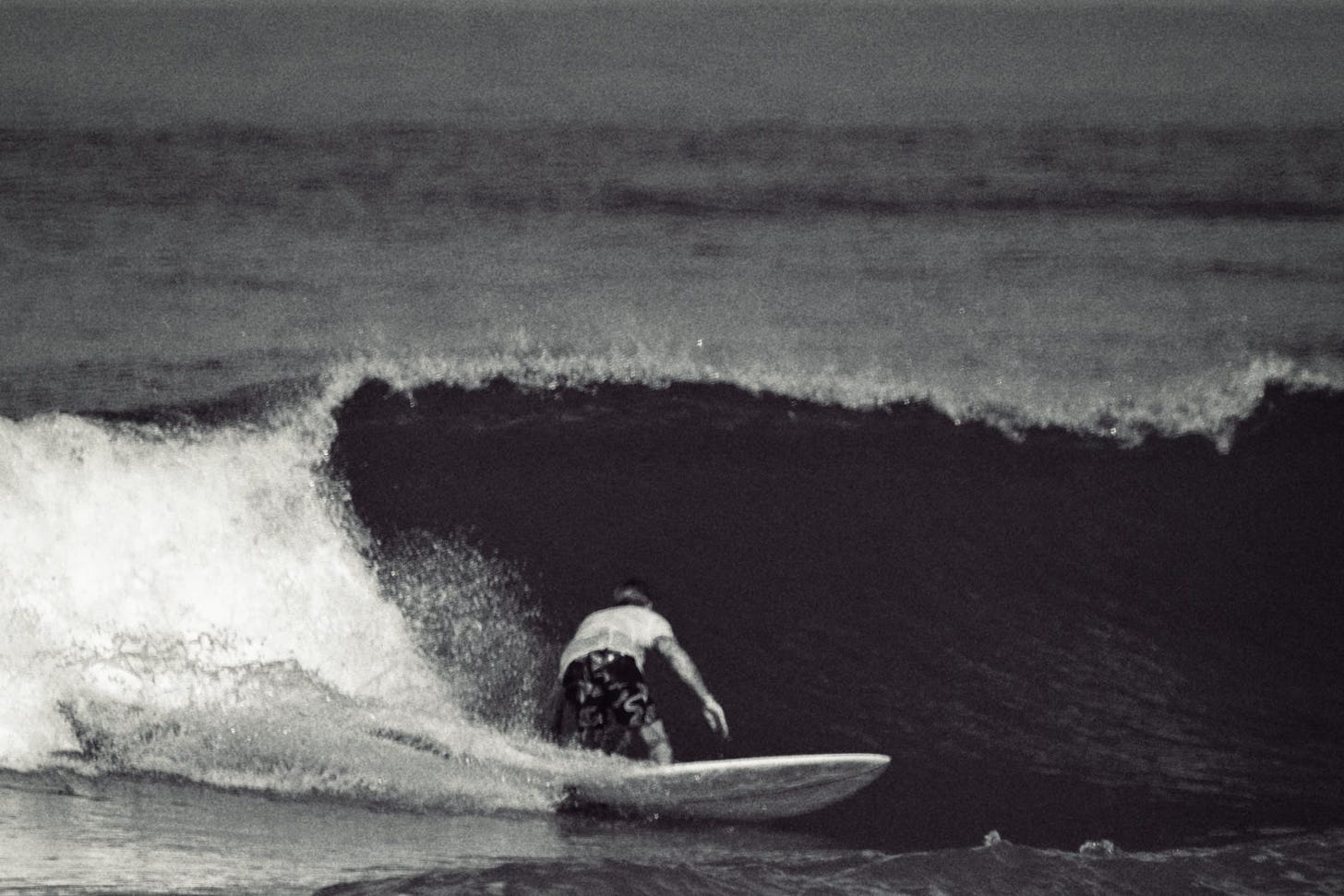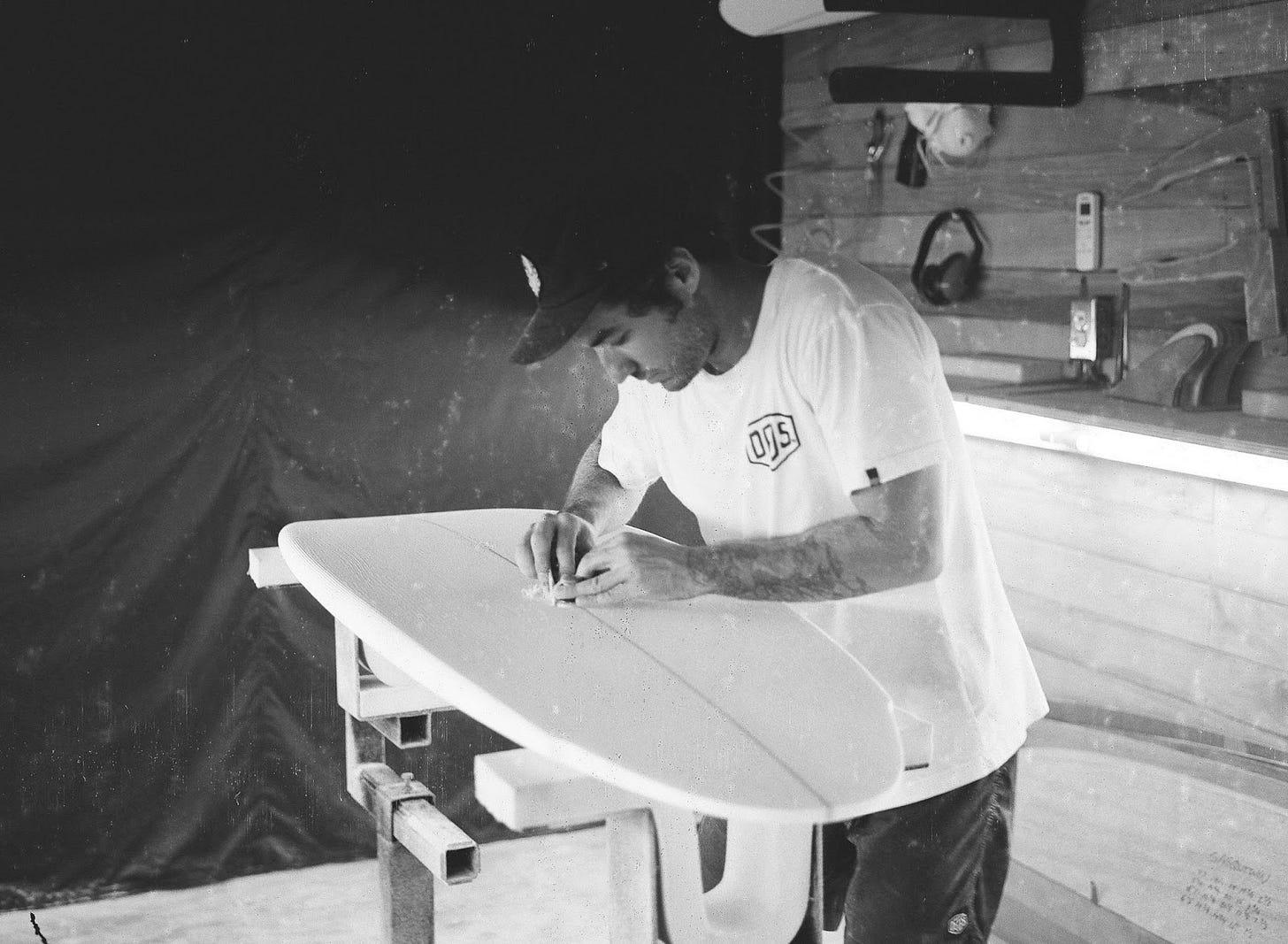The Board Shaper Edition
On craft, surfing, and feel
Eric Matthies (EM) is a friend of WITI, a part-time resident of Costa Rica, and, as you will see, an avid surfer. He is responsible for one of the best WITI editions of all time. -Colin (CJN)
Eric here. My fascination with surfing began before I ever got near an ocean-borne wave. As a Chicago kid deeply immersed in skateboarding, I knew that the roots of my preferred mode of expression and transportation were in the water. Way back in AP History, we were challenged with a single assignment for the semester—write a 100-page historical research paper on the topic of our choice. The rules were that the subject had to have at least six published books to be footnoted as references throughout. At that time, skateboarding did not have more than two published books and a couple of magazines, so I turned to the source: surfing. I wrote out the history of the sport, and, in the process, I got hooked. I rode my skateboard in studied imitation of the carving, flowing, speeding lines of legendary surfers. I became fascinated by guys like Tom Blake (from Wisconsin!), who studied hydrodynamics and physics, translating that knowledge into early surfboard design.
Flash forward to the present; I’ve been surfing almost twenty-five years (though some days you’d still not recognize me from all the other kook beginners in the lineup). One of the most amazing things about surfing is that you can have your equipment custom-tailored to you and to the wave you’re planning to ride. I can’t think of any other activity where that’s true at an affordable level. Modern times means modern manufacturing, so the majority of the boards in the world’s waves are CNC-machined replicas of the models ridden by professional surfers. These boards are generally white, made of epoxy, feature five fin boxes, and have a carbon-fiber cloth stripe down the center. They are replicable versions of contest-winning, highly refined designs. They work just fine. In my view, they’re ugly, and they produce ugly repetitive surfing in almost all but the namesake professional or a comparably stylish practitioner.
Anyone can still find a shaper who will make a board to exacting specifications by hand. You simply need to be willing to have a conversation or six, plunk down a deposit, be very patient, and you’ll end up with the wave-riding equivalent of a Savile Row suit. WITI colleague Joseph Dana has even built a few boards of his own. I’ve surfed all over the world on all manner of craft from bodysurfing hand-planes measuring less than one foot to rented hunks of styrofoam over ten feet long. My current quiver of wave riding equipment is entirely hand-built, mostly from the imagination of an elusive zen guru named Jimmie Hines.
Why is this interesting?
In no other sport but surfing could you spend around a thousand bucks and walk away with a highly functional object-d’art made exclusively for you. Sure, you can get fitted for a custom-made bicycle (gone down that rabbit hole too), or order up a custom-tuned golf club, but I’d argue those are not in the same league. A surfboard isn’t just made to measure to your body’s dimensions, it can also be dialed into a specific type of wave you love to ride or intend to ride. It carries the DNA of the experienced, imaginative artisan who created it. In surfing, the people who make the boards are equally as important to the history and lore of the sport as those who ride them. That’s because they’ve crafted equipment that made history in some of the biggest and best waves in the world. The men and women who ride these waves pledge deep allegiances to their shapers, in some cases forming lifelong relationships that have raised the surfer, the shaper, and the sport to new levels. Getting a board from one of these legendary masters isn’t that easy or simple; like great artists, they have long waiting lists, high prices, and are often notoriously fickle about who they’ll work with. Boards from the hands of Dale Velzy or Dick Brewer have sold for tens if not hundreds of thousands of dollars at auction. There’s plenty of other great craftspeople in the sport, so much like finding a good tailor to make your clothes, it’s a fun process to find a shaper.
A board starts as a blank rectangle of foam— usually polystyrene. In modern times with a deep commitment to environmental efforts, less toxic materials are becoming more common. Cork, algae-based foams, reclaimed balsa and other substances are being successfully employed. There are some shapers, like Ry Harris in Los Angeles, who base their entire business around eco-conscious techniques and materials. Spend enough time floating around the world’s oceans with a thick layer of “ocean plastic” debris and it’s easy to appreciate how important it is to keep the art of surfboard manufacturing in line with environmental concerns.
After deciding on the dimensions and style of the board to be made, the next step of shaping the board is to saw the block of foam into a basic shape using a template. It’s then planed down with a series of power tools and hand tools to a precise set of measurements and, in the hands of a master, feelings about what will work best. Traditionally, it’s then passed along to a glasser, who meticulously layers fiberglass over the foam, then seals it with resin and catalyst. These are toxic, so again we’re seeing changes in the materials used in these processes. The glassing is also when any color tint or spray is applied and it’s generally the color that most people view as the “custom” aspect.
Most of the boards I’ve commissioned over the years came through a series of phone calls and emails, followed by a lot of patience about the stated vs. actual delivery date. In 2019 I was surfing in Costa Rica and struck up a conversation in the water with a guy named Forrest Minchinton. Forrest happens to be a world-class motocross racer and he was querying me about some specifics in post-production for a documentary about his attempt to win the Baja 1000. As it turned out, Forrest also is the son of a legendary underground shaper named Mike Minchinton. Like father like son, Forrest mows foam into beautiful boards and had just opened a shaping bay down the street from where we both lived. Realizing it was a first opportunity to actually surf with a shaper and work on a board together, I immediately placed an order. I wanted a board for the waves we were surfing—punchy head high to overhead sandbar beach break which demanded an ability to generate speed, turn sharply but also carve longer lines when warranted. For the first half of my life, I’d been skating the way I imagined surfing would be, now after a couple of decades in the water I wanted to surf as I skated. We grabbed a few beers and wrote up some dimensions—length, width, volume, what kind of tail shape, and fin configuration I was after. We landed on a version of an existing design of his: a relatively short twin fin with a round pin tail, some very specific twists to the rails, and a spiraling bottom concave.
I’ve had the professional pleasure of filming some amazing craftsmen over the years—indigenous carvers, third-generation metalsmiths, blue-chip artists. I’ve spent many hours in state-of-the-art ateliers, basement studios, and funky skunkworks sheds. The Minchinton’s new shaping bay was in a still under construction hotel/restaurant/shop compound. With a week until the grand opening, there was chaos all around, but inside the air-cooled bay it was calm. As soon as we’d penciled numbers for the design, Forrest grabbed a blank and a saw and began the process. Hanging out while my new watercraft came to life in Forrest’s hands was one of the more fun experiences I’ve had. Mike would wander in from time to time, along with a few of our local crew. It was like swapping stories in a hotrodders garage. I walked across the road and bought another six-pack. Forrest asked me “how loose do you set up your trucks on your skateboard?” I said I liked to shake the board and have the trucks wiggle. He smiled and kept moving the Skil planer around the hunk of foam in front of us. In a few hours, it looked like a screamingly fast, maneuverable surfboard. I dropped by a few more times that week to chat with Forrest while he carved, sanded, and foiled out the wooden keel fins that would complete the craft. I secretly hoped I could honor it by riding it well. Getting it glassed, colored, and sanded took another month so I had time to change my mind about aesthetics dozens of times. In the end, I brought over a dappled leaf from a local vine. I gave it to the glasser and let him do his thing, knowing that the tints, resin, and catalyst would have their own magical input to the final look.
Like anything that one connects to through story, my board from Forrest feels tuned to me in a way that goes beyond the dimensions we put on paper that evening over beers. It definitely speaks to the waves out front, responding in speedy snaps and arching turns. Occasionally, I rise up to the level the board demands and everything comes together in an orchestrated dance. Sure, with my rather pedestrian surfing I could have saved a few bucks and gotten the instant gratification of an off-the-shelf computer-shaped board. If I had, I wouldn’t be learning new stories and sharing them with the ocean. I wouldn’t have made some new friends, and I wouldn’t be surfing the way I want surfing to feel. (EM)
Photo of the day:
Quick Links
New Plastics Economy (EM)
The King of Pavones (EM)
The Future Is Female (EM)
Noah (NRB) & Colin (CJN) & Eric (EM)
—
Why is this interesting? is a daily email from Noah Brier & Colin Nagy (and friends!) about interesting things. If you’ve enjoyed this edition, please consider forwarding it to a friend. If you’re reading it for the first time, consider subscribing (it’s free!).


